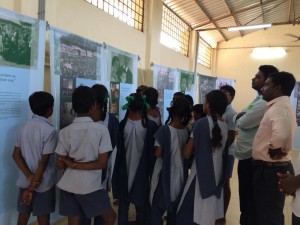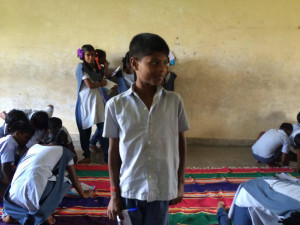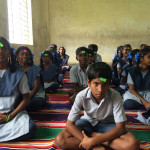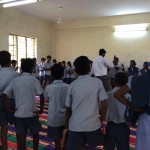Azim Premji Foundation in collaboration with the Directorate of School Education, Puducherry and The Seagull Foundation for the Arts, Kolkata hosted the exhibition in three venues over a period of eighteen days from 24 January to 11 February, 2016. The exhibition was held in three places: Vivekanand Government Higher Secondary School, Villianur, Government Technical School, Lawspet and Jawahar Navodaya in Kalapet. Over 2500 students of class VIII from 52 schools visited during the course of the exhibitions. Out of this, 48 schools were government schools and 4 were alternate schools. The department had issued circulars to the government schools and allotted time slots for visit. Apart from school children, public also visited the exhibition. The event was covered in The Hindu, New Indian Express, Dina Malar and Times of India which helped reach out to the public. A student of Mass Communication from Pondicherry University, visited the exhibition to work on a project on this theme.
Each batch of students spent around three hours at the exhibition venue. During the first 40 minutes, students attended an interactive session which dealt with the idea of bias and discrimination followed by a discussion on having to accept and respect differences. They then proceeded to view the Anne Frank exhibition for 40 minutes which had pictorial panels highlighting the important turn points in Anne’s life and World History. Post the exhibition, they watched a twenty two minute Tamil documentary on the life of Anne Frank which reinforced the ideas they had seen in the exhibition. Finally, students sat for a discussion for about another 40 minutes, sharing what they have learnt from the sessions and taking a resolution to respect everyone and not to avoid others based on differences. Overall each batch spent 2.5 hours at the venue.
15 teachers had volunteered to be with us in this program and they actively took up the role of explaining the panels to the students. On 24 January, there was an initial orientation for these teachers co-facilitated by Ms. Megha Malhotra from Seagull. Teachers watched the movie on Anne Frank, read parts of the diary and engaged in a discussion to understand the aims of the exhibition. There were two main discussions that took place. One was on historical aspect – the context of the World War II, rise of Hitler and viewing it through the eyes of a young girl. The other was on our approach with the students, that it should be more transformative than informative. Megha began the discussion asking teachers what they felt about the exhibition, what touched them the most and how would they connect it to today’s scenario. Discussion on identity politics, violence, etc. helped them to understand the aim of the exhibition. She then went on to explain each of the panels. Every new batch of teachers were briefed for two hours to help them facilitate the panels with the students.
The first forty minute session was to drive two main points. The first point is that all human beings are unique and possess differences. Since no two people are the same, it is important that we accept and respect these differences. Discrimination begins from an inability to accept differences. This was done with the help an activity. All children were given a sheet of paper and asked to close their eyes and follow a set of instructions. They were asked to fold and tear the paper multiple times. At the end of it, they were asked to open their eyes and unfold the paper. It was interesting to see the patterns that were created and also to notice that no two students had managed to create the exact same pattern.
The second point was to make them aware of how we isolate or separate people based on differences and to sensitize them towards this issue. This activity had to be carried out in silence – without speaking or gesturing to their peers. Students were asked to close their eyes while the volunteers (teachers and facilitators) pasted different colored stickers on their foreheads. Students would not be aware of the color on their heads. On opening their eyes, they had to find the group they belonged to by walking towards or away from each other. Same color stickers form a group and they must not accommodate other color stickers in their group. The group must walk/ move away. Among the lot, there were a few single colors. As students started forming groups, these children were left separated without being taken into any of the groups. Once all the groups were formed and a few were left separate, the students were asked to share their experiences and feelings.
Read the full report here: Anne Frank Exhibition report document
– Report from the Azim Premji Foundation




